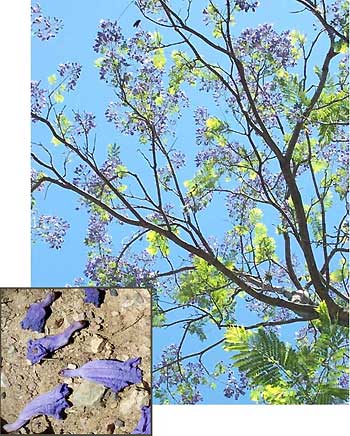Excerpts from Jim Conrad's
Naturalist Newsletter
from the April 14, 2007 Newsletter Issued from Sierra Gorda Biosphere Reserve Headquarters in Jalpan, Querétaro, MÉXICO
JACARANDAS FLOWERING

For the last two or three weeks all across hot-weather Mexico in towns and along roads the Jacarandas have blossomed into gigantic, lilac-colored bouquets. Even if you're the kind who never looks skyward the tree's blossoms are impossible to miss, for they strew the ground beneath trees with blue polka dots. I think the trees are most riveting when, as shown at the right, you stand beneath one and look up through its branches on a dazzlingly sunny day such as we've had this week. Visualize the translucent purplish flowers against the deep blue sky, and freshly emerged, ferny leaves emerald green and wind-shaken, set among deliquescing, black-silhouette branches with silver edges.
The tree, growing up to 50 feet high, is JACARANDA MIMOSIFOLIA, called Jacaranda (ha-ka-RAHN-da) in Spanish, and in English often Blue Jacaranda. It's a native of South America but planted worldwide in the tropics, even in southern Florida and places like Phoenix, Arizona. Another reason jacarandas are popular is that they can be grown easily from seeds or cuttings.
Jacaranda's two-inch long, tubular flowers might remind Eastern North Americans of Catalpa or Trumpet-creeper blossoms in size and shape. They should, because Jacaranda belongs to the same family as those plants, the Bignonia Family. Maybe half the species in that family are woody vines and the vast majority have opposite leaves. Jacarandas distinguish themselves in the family by being trees with twice-pinnately compound leaves, and having bluish flowers with five corolla lobes but only four fertile stamens. The fifth stamen is reduced to a sterile, club-shaped thing, a "staminode," typically bearing a dense tuft of bristles. On the Internet I read that the staminode's "... bristles are critically important in keeping small pollen-foraging bees closer to the stigma, resulting in more frequent contact and pollen transfer."
About those lovely blue flowers that fall onto the ground once they're pollinated, another website says of the trees that "The ground below them turns rapidly blue, and some gardeners might object to that quantity of litter."
What an amazing diversity of headsets we humans are capable of. It's scary sometimes.